Report: Structure, Culture, and Impact of English Legal Systems
VerifiedAdded on 2023/01/13
|19
|1710
|22
Report
AI Summary
This report provides a comprehensive overview of the English legal system, encompassing both civil and criminal law. It details the structure and functions of magistrate and Crown courts, the appeal processes, and the criminal justice system's stages, including investigation, arrest, prosecution, and arraignments. The report also explores various types and principles of law, particularly focusing on criminal law and the legality principle. Furthermore, it analyzes the role of the criminal justice system in addressing criminal offenses and maintaining law and order in England and Wales. The conclusion emphasizes the effectiveness of the English legal system, highlighting the roles of the courts and the appeal mechanisms available to those dissatisfied with court decisions. The report also provides references to relevant academic resources.
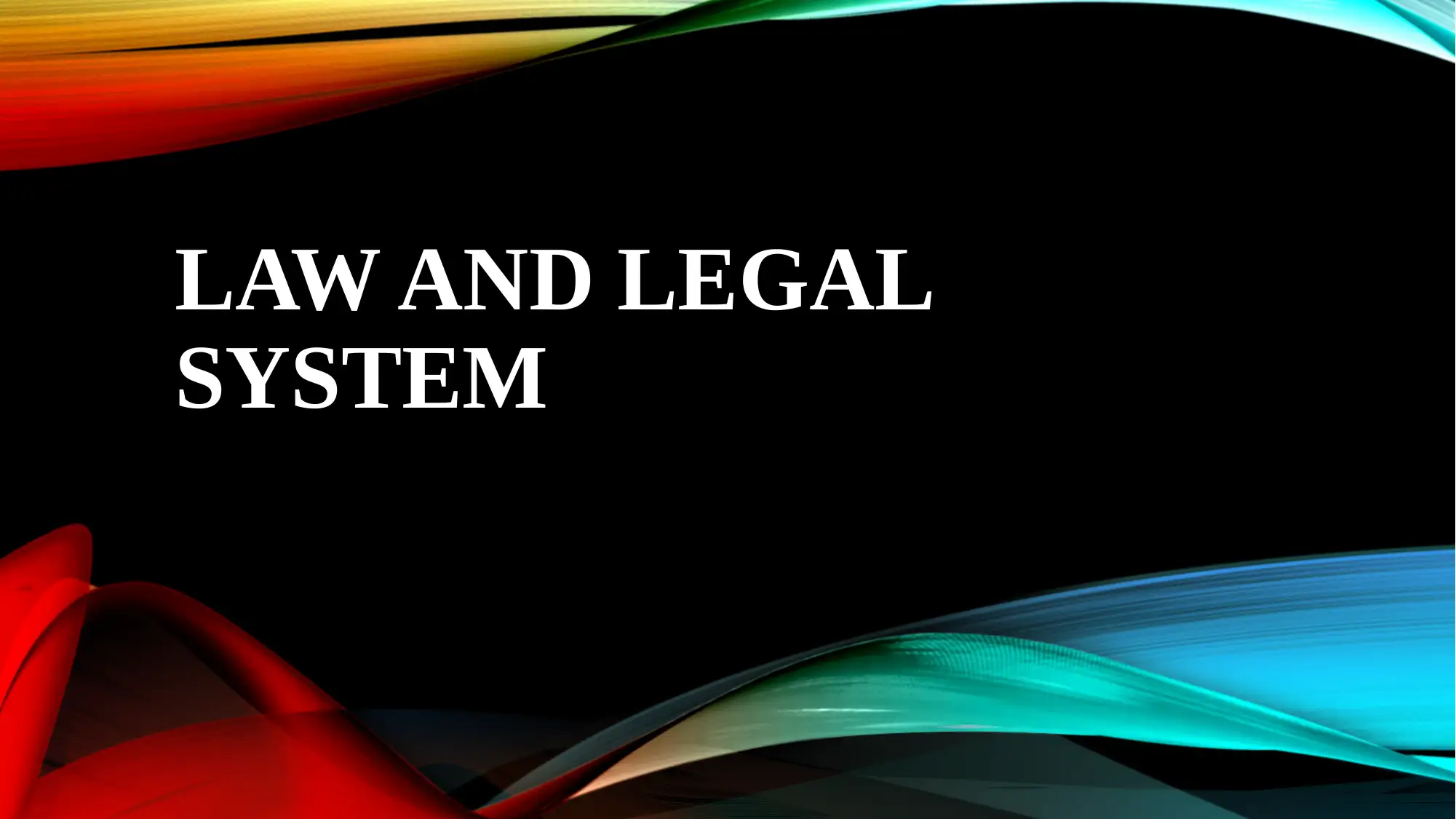
LAW AND LEGAL
SYSTEM
SYSTEM
Paraphrase This Document
Need a fresh take? Get an instant paraphrase of this document with our AI Paraphraser
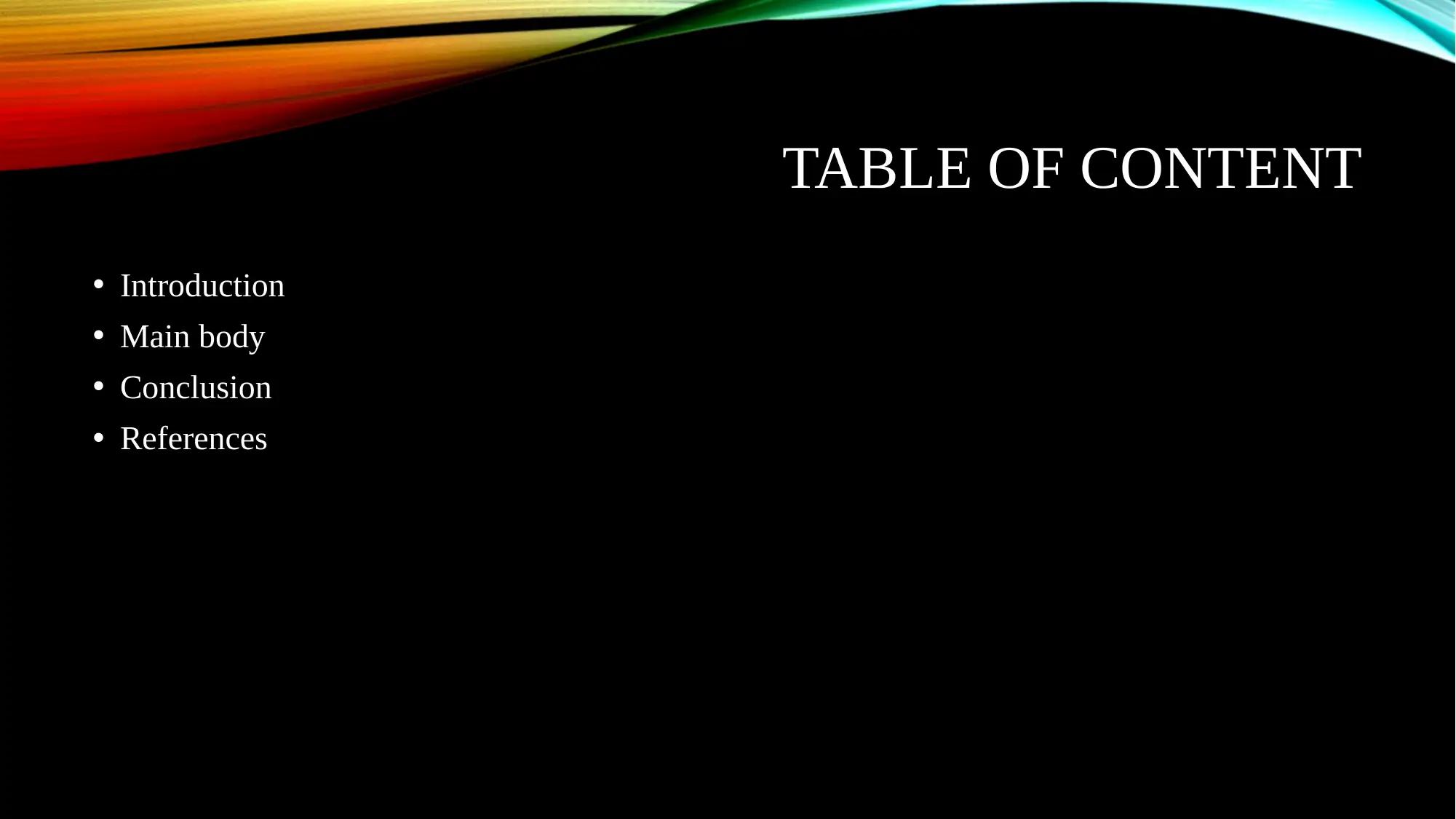
TABLE OF CONTENT
• Introduction
• Main body
• Conclusion
• References
• Introduction
• Main body
• Conclusion
• References
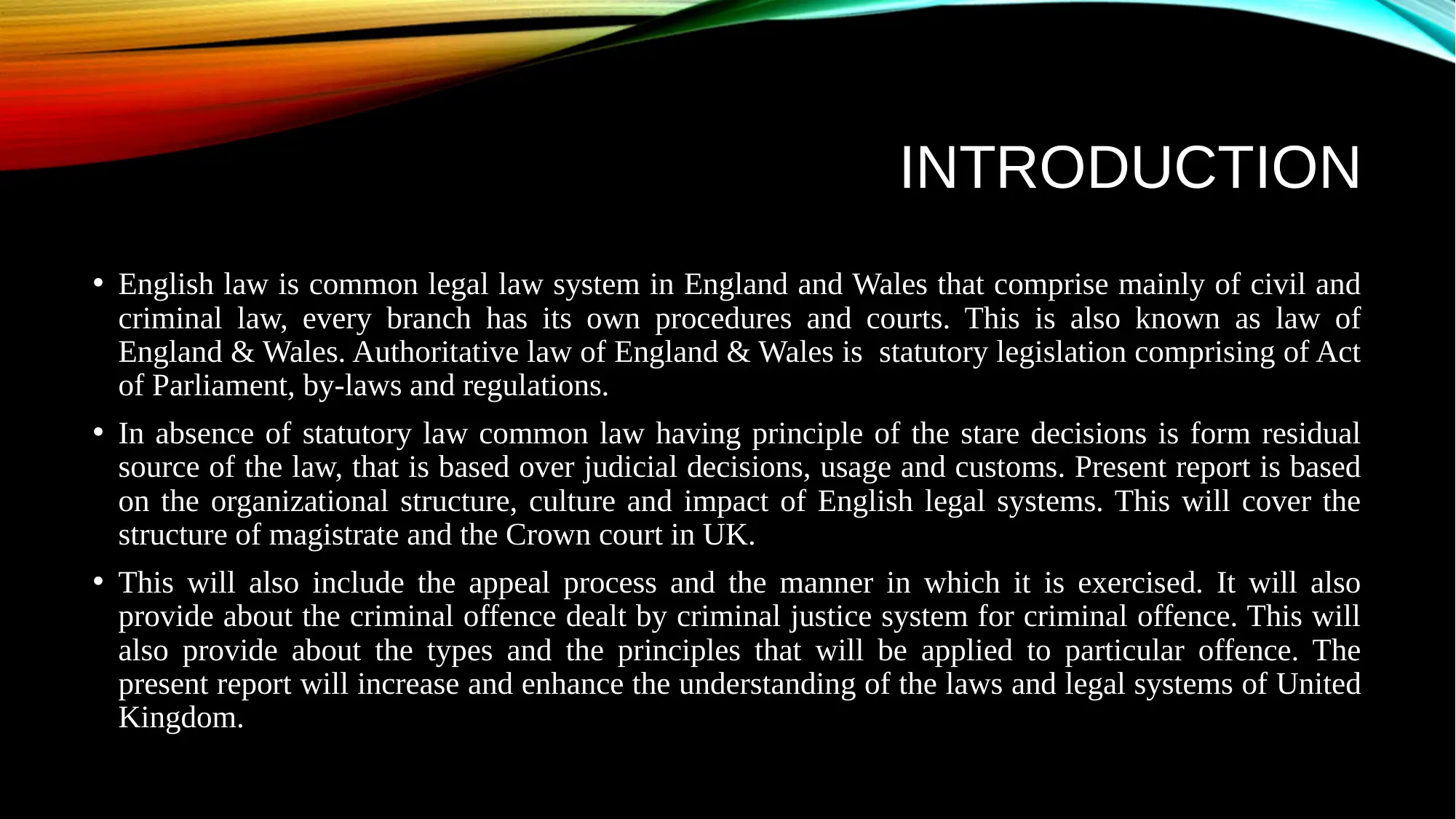
INTRODUCTION
• English law is common legal law system in England and Wales that comprise mainly of civil and
criminal law, every branch has its own procedures and courts. This is also known as law of
England & Wales. Authoritative law of England & Wales is statutory legislation comprising of Act
of Parliament, by-laws and regulations.
• In absence of statutory law common law having principle of the stare decisions is form residual
source of the law, that is based over judicial decisions, usage and customs. Present report is based
on the organizational structure, culture and impact of English legal systems. This will cover the
structure of magistrate and the Crown court in UK.
• This will also include the appeal process and the manner in which it is exercised. It will also
provide about the criminal offence dealt by criminal justice system for criminal offence. This will
also provide about the types and the principles that will be applied to particular offence. The
present report will increase and enhance the understanding of the laws and legal systems of United
Kingdom.
• English law is common legal law system in England and Wales that comprise mainly of civil and
criminal law, every branch has its own procedures and courts. This is also known as law of
England & Wales. Authoritative law of England & Wales is statutory legislation comprising of Act
of Parliament, by-laws and regulations.
• In absence of statutory law common law having principle of the stare decisions is form residual
source of the law, that is based over judicial decisions, usage and customs. Present report is based
on the organizational structure, culture and impact of English legal systems. This will cover the
structure of magistrate and the Crown court in UK.
• This will also include the appeal process and the manner in which it is exercised. It will also
provide about the criminal offence dealt by criminal justice system for criminal offence. This will
also provide about the types and the principles that will be applied to particular offence. The
present report will increase and enhance the understanding of the laws and legal systems of United
Kingdom.
⊘ This is a preview!⊘
Do you want full access?
Subscribe today to unlock all pages.

Trusted by 1+ million students worldwide
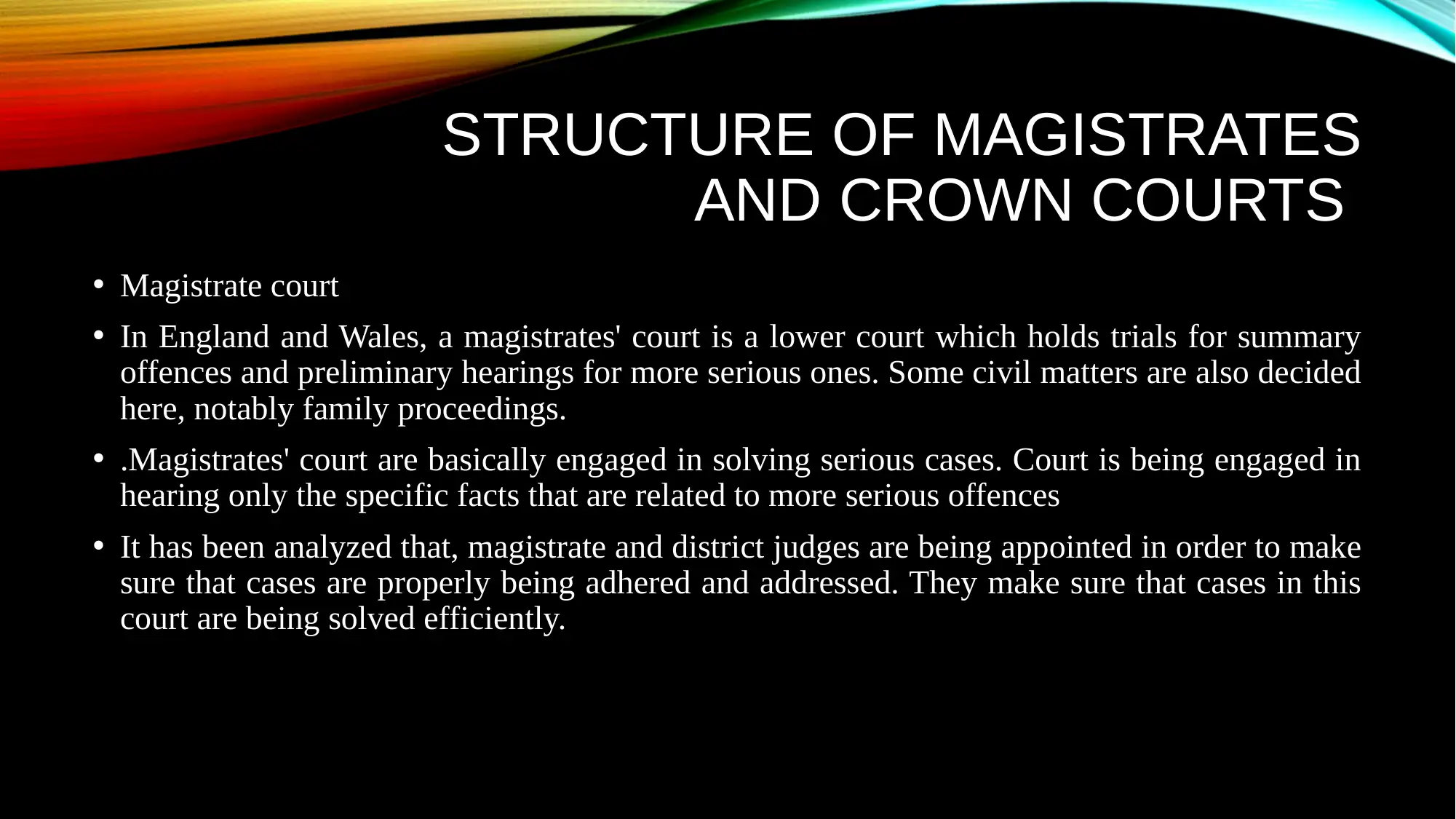
STRUCTURE OF MAGISTRATES
AND CROWN COURTS
• Magistrate court
• In England and Wales, a magistrates' court is a lower court which holds trials for summary
offences and preliminary hearings for more serious ones. Some civil matters are also decided
here, notably family proceedings.
• .Magistrates' court are basically engaged in solving serious cases. Court is being engaged in
hearing only the specific facts that are related to more serious offences
• It has been analyzed that, magistrate and district judges are being appointed in order to make
sure that cases are properly being adhered and addressed. They make sure that cases in this
court are being solved efficiently.
AND CROWN COURTS
• Magistrate court
• In England and Wales, a magistrates' court is a lower court which holds trials for summary
offences and preliminary hearings for more serious ones. Some civil matters are also decided
here, notably family proceedings.
• .Magistrates' court are basically engaged in solving serious cases. Court is being engaged in
hearing only the specific facts that are related to more serious offences
• It has been analyzed that, magistrate and district judges are being appointed in order to make
sure that cases are properly being adhered and addressed. They make sure that cases in this
court are being solved efficiently.
Paraphrase This Document
Need a fresh take? Get an instant paraphrase of this document with our AI Paraphraser
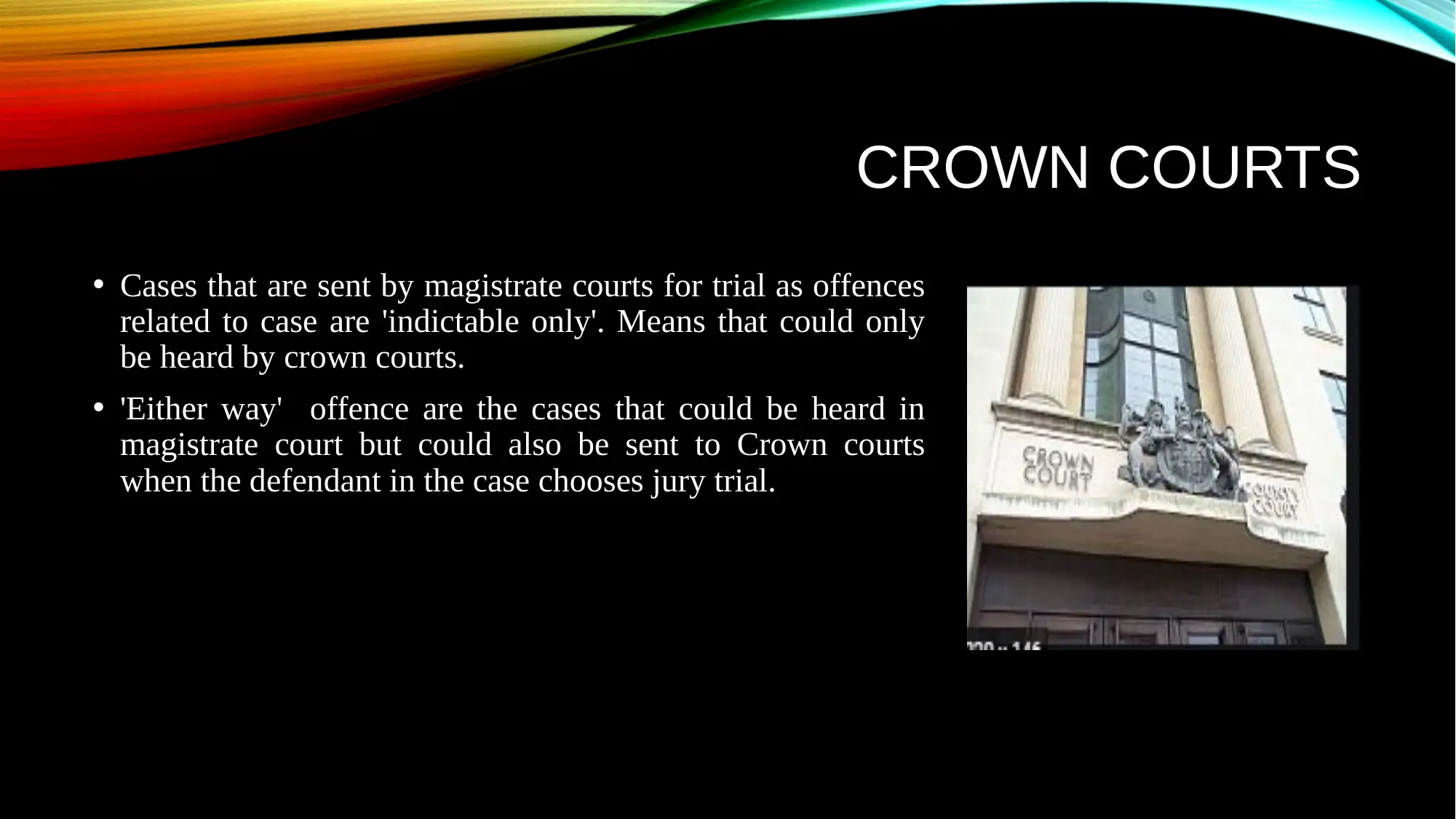
CROWN COURTS
• Cases that are sent by magistrate courts for trial as offences
related to case are 'indictable only'. Means that could only
be heard by crown courts.
• 'Either way' offence are the cases that could be heard in
magistrate court but could also be sent to Crown courts
when the defendant in the case chooses jury trial.
• Cases that are sent by magistrate courts for trial as offences
related to case are 'indictable only'. Means that could only
be heard by crown courts.
• 'Either way' offence are the cases that could be heard in
magistrate court but could also be sent to Crown courts
when the defendant in the case chooses jury trial.
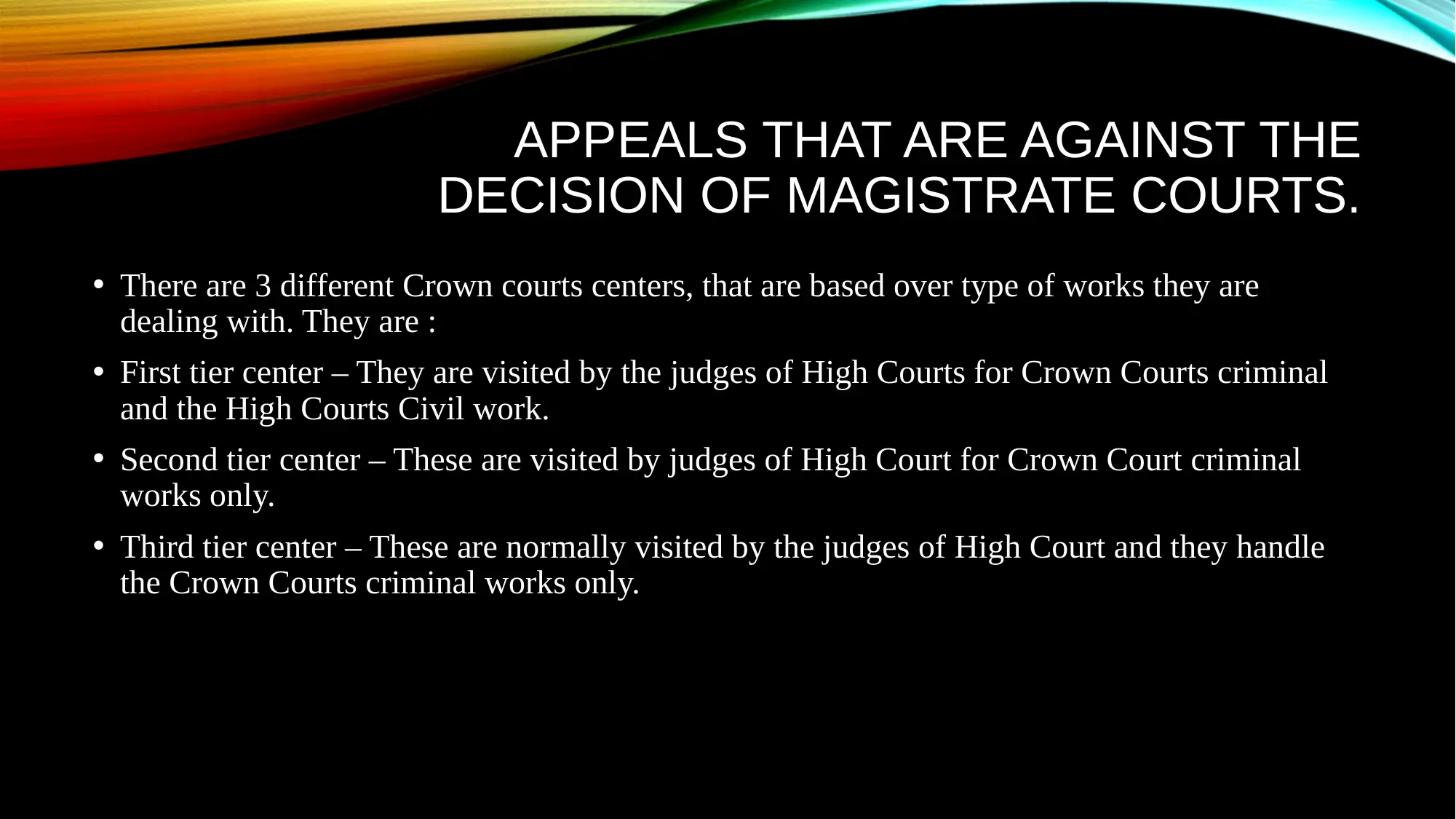
APPEALS THAT ARE AGAINST THE
DECISION OF MAGISTRATE COURTS.
• There are 3 different Crown courts centers, that are based over type of works they are
dealing with. They are :
• First tier center – They are visited by the judges of High Courts for Crown Courts criminal
and the High Courts Civil work.
• Second tier center – These are visited by judges of High Court for Crown Court criminal
works only.
• Third tier center – These are normally visited by the judges of High Court and they handle
the Crown Courts criminal works only.
DECISION OF MAGISTRATE COURTS.
• There are 3 different Crown courts centers, that are based over type of works they are
dealing with. They are :
• First tier center – They are visited by the judges of High Courts for Crown Courts criminal
and the High Courts Civil work.
• Second tier center – These are visited by judges of High Court for Crown Court criminal
works only.
• Third tier center – These are normally visited by the judges of High Court and they handle
the Crown Courts criminal works only.
⊘ This is a preview!⊘
Do you want full access?
Subscribe today to unlock all pages.

Trusted by 1+ million students worldwide
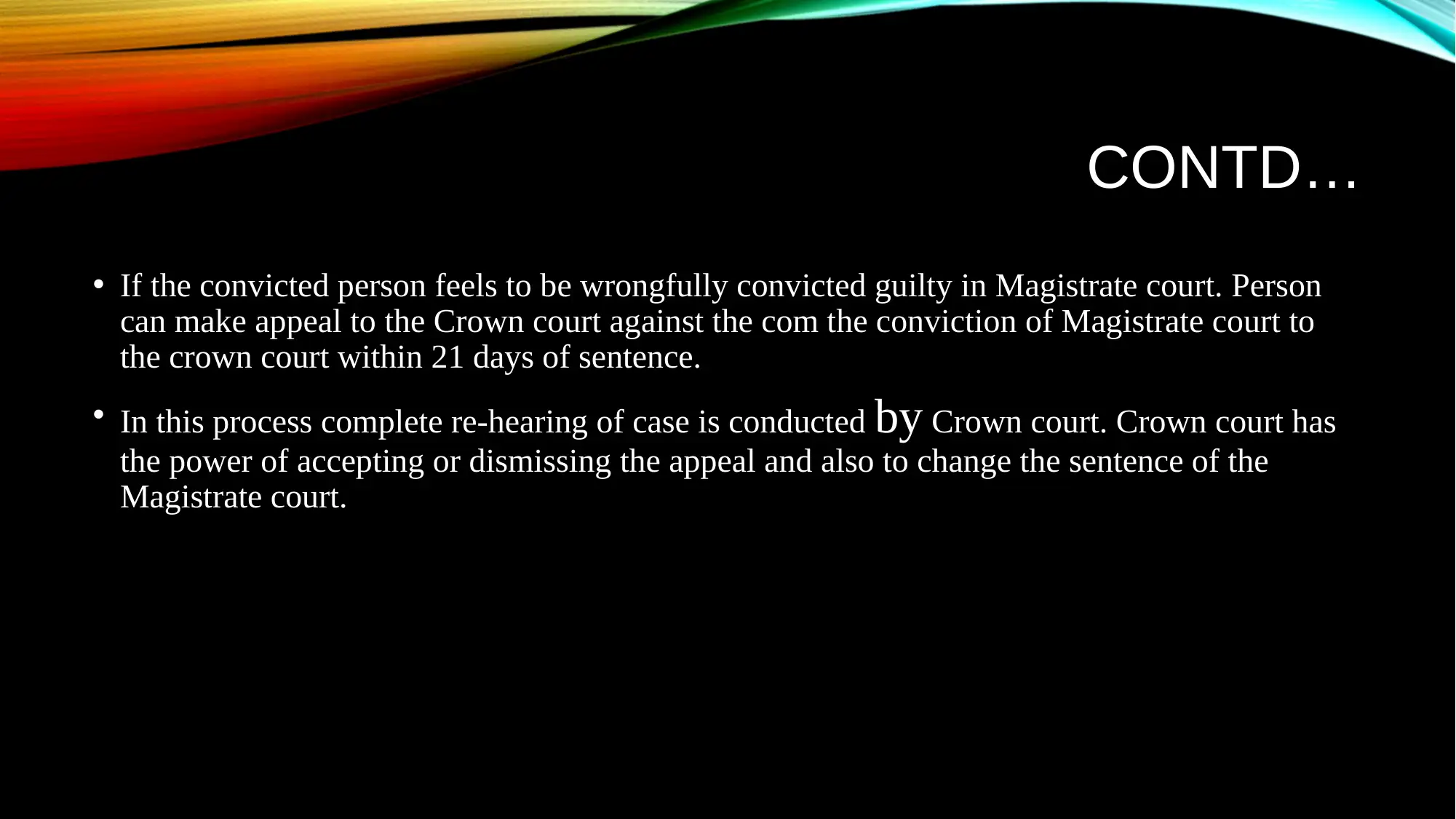
CONTD…
• If the convicted person feels to be wrongfully convicted guilty in Magistrate court. Person
can make appeal to the Crown court against the com the conviction of Magistrate court to
the crown court within 21 days of sentence.
• In this process complete re-hearing of case is conducted by Crown court. Crown court has
the power of accepting or dismissing the appeal and also to change the sentence of the
Magistrate court.
• If the convicted person feels to be wrongfully convicted guilty in Magistrate court. Person
can make appeal to the Crown court against the com the conviction of Magistrate court to
the crown court within 21 days of sentence.
• In this process complete re-hearing of case is conducted by Crown court. Crown court has
the power of accepting or dismissing the appeal and also to change the sentence of the
Magistrate court.
Paraphrase This Document
Need a fresh take? Get an instant paraphrase of this document with our AI Paraphraser
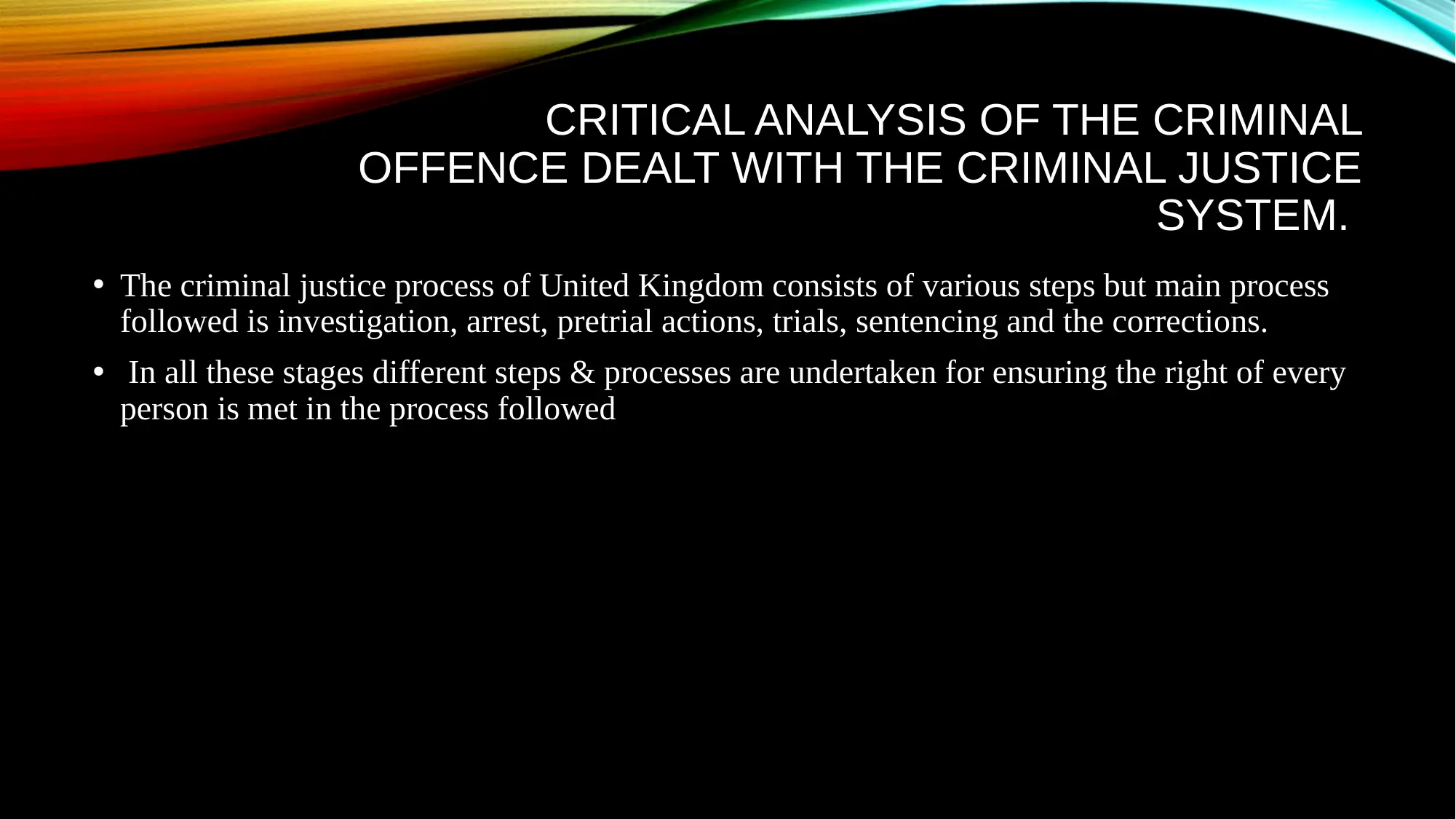
CRITICAL ANALYSIS OF THE CRIMINAL
OFFENCE DEALT WITH THE CRIMINAL JUSTICE
SYSTEM.
• The criminal justice process of United Kingdom consists of various steps but main process
followed is investigation, arrest, pretrial actions, trials, sentencing and the corrections.
• In all these stages different steps & processes are undertaken for ensuring the right of every
person is met in the process followed
OFFENCE DEALT WITH THE CRIMINAL JUSTICE
SYSTEM.
• The criminal justice process of United Kingdom consists of various steps but main process
followed is investigation, arrest, pretrial actions, trials, sentencing and the corrections.
• In all these stages different steps & processes are undertaken for ensuring the right of every
person is met in the process followed
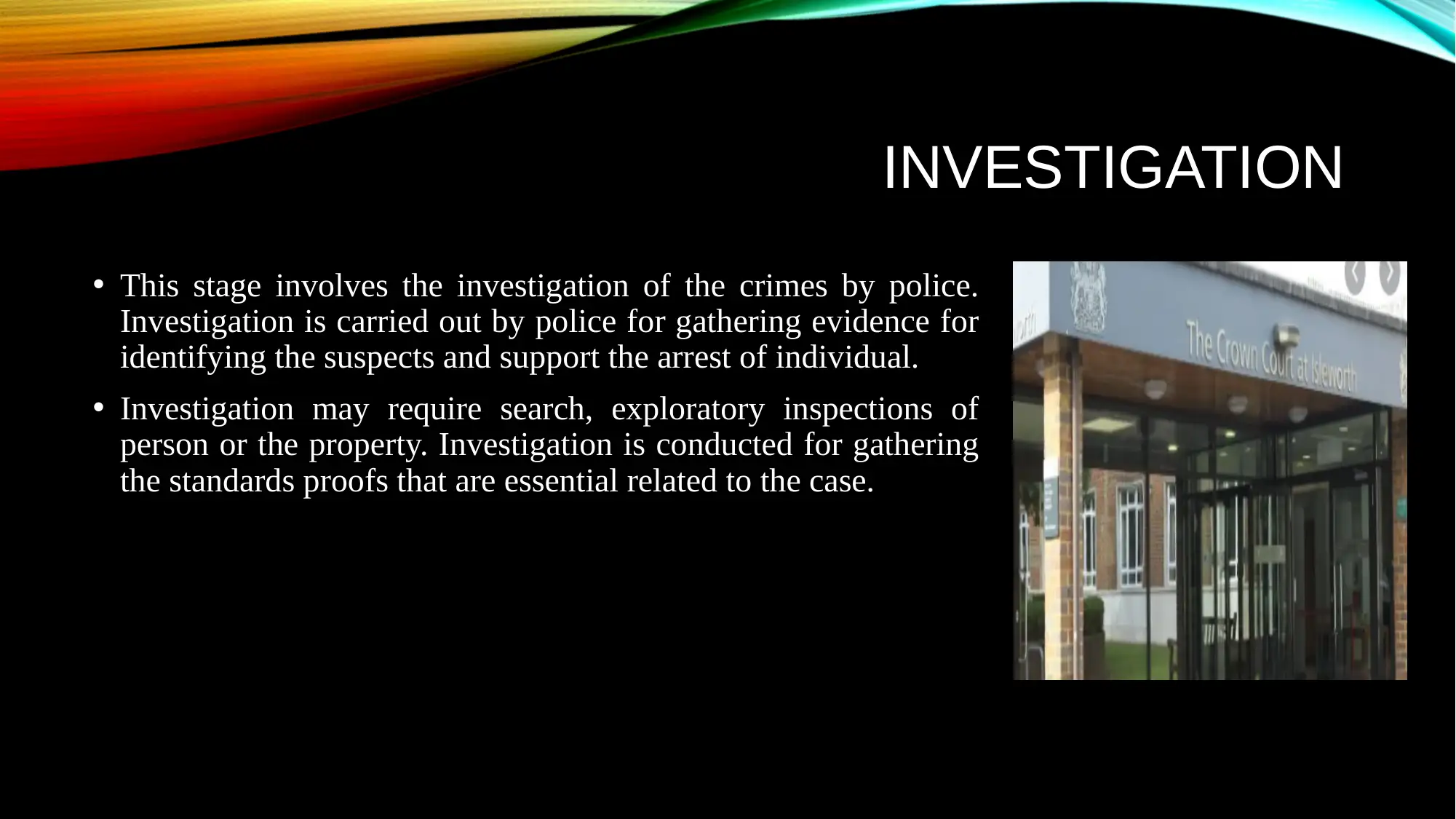
INVESTIGATION
• This stage involves the investigation of the crimes by police.
Investigation is carried out by police for gathering evidence for
identifying the suspects and support the arrest of individual.
• Investigation may require search, exploratory inspections of
person or the property. Investigation is conducted for gathering
the standards proofs that are essential related to the case.
• This stage involves the investigation of the crimes by police.
Investigation is carried out by police for gathering evidence for
identifying the suspects and support the arrest of individual.
• Investigation may require search, exploratory inspections of
person or the property. Investigation is conducted for gathering
the standards proofs that are essential related to the case.
⊘ This is a preview!⊘
Do you want full access?
Subscribe today to unlock all pages.

Trusted by 1+ million students worldwide
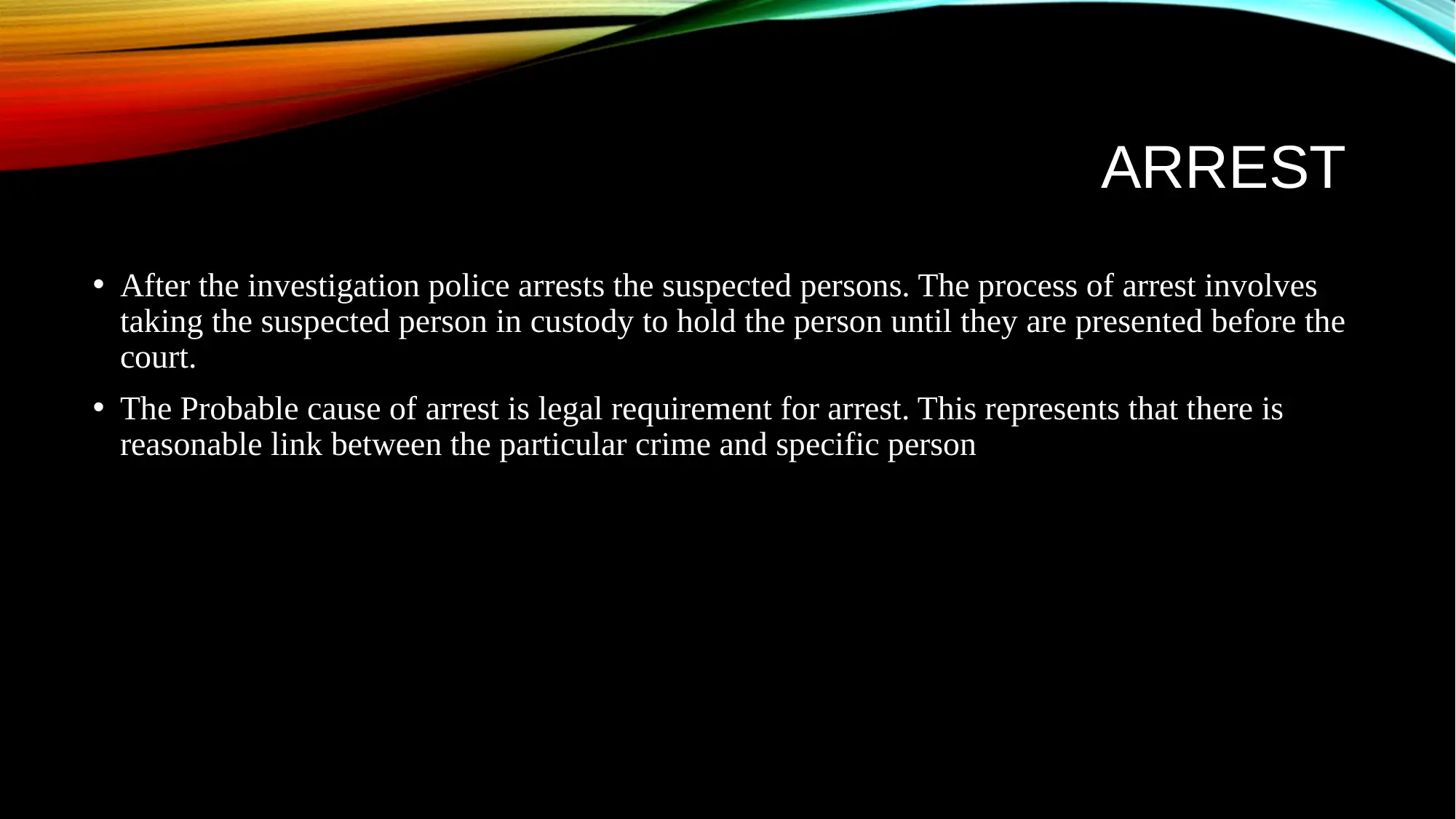
ARREST
• After the investigation police arrests the suspected persons. The process of arrest involves
taking the suspected person in custody to hold the person until they are presented before the
court.
• The Probable cause of arrest is legal requirement for arrest. This represents that there is
reasonable link between the particular crime and specific person
• After the investigation police arrests the suspected persons. The process of arrest involves
taking the suspected person in custody to hold the person until they are presented before the
court.
• The Probable cause of arrest is legal requirement for arrest. This represents that there is
reasonable link between the particular crime and specific person
Paraphrase This Document
Need a fresh take? Get an instant paraphrase of this document with our AI Paraphraser
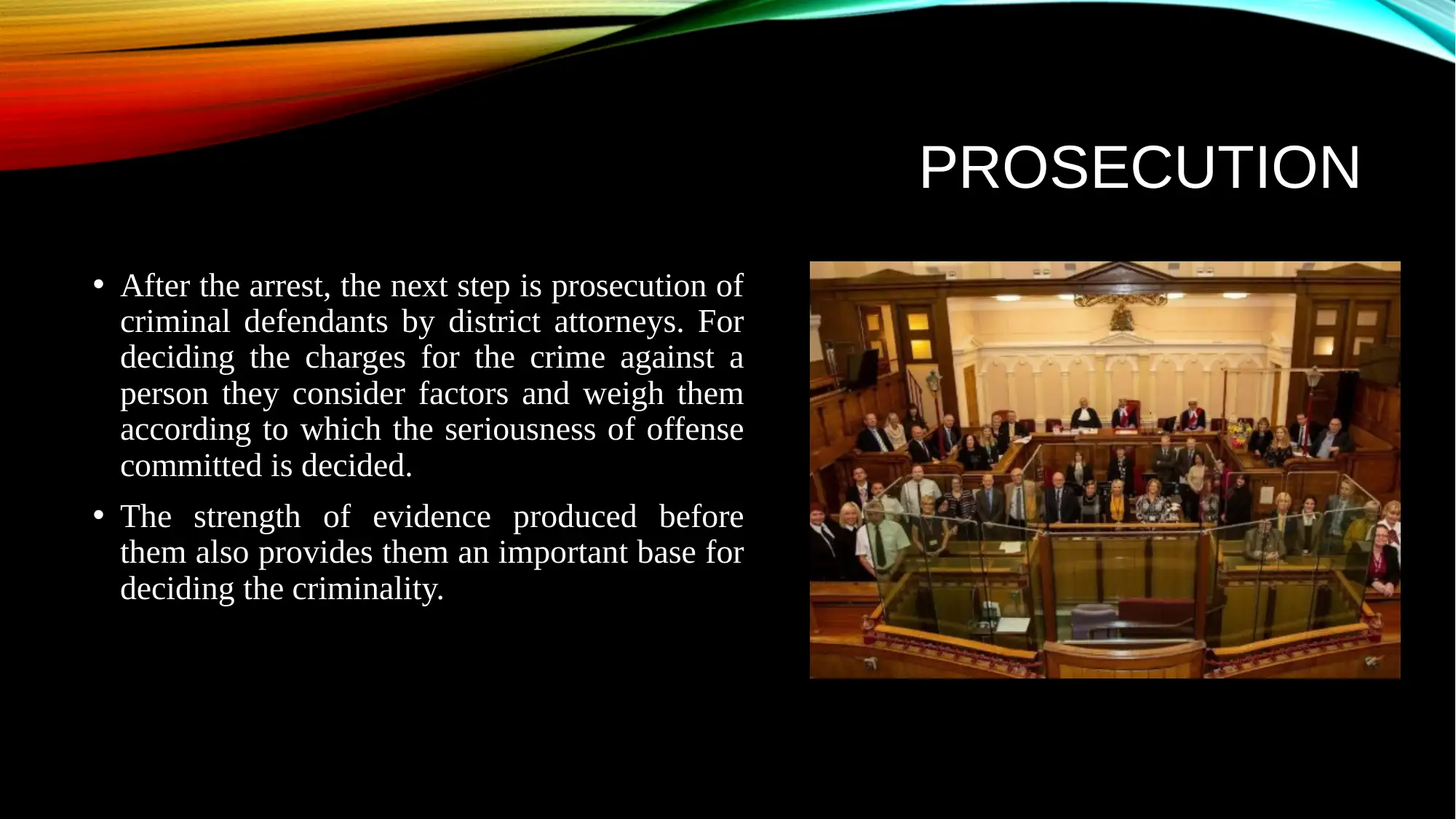
PROSECUTION
• After the arrest, the next step is prosecution of
criminal defendants by district attorneys. For
deciding the charges for the crime against a
person they consider factors and weigh them
according to which the seriousness of offense
committed is decided.
• The strength of evidence produced before
them also provides them an important base for
deciding the criminality.
• After the arrest, the next step is prosecution of
criminal defendants by district attorneys. For
deciding the charges for the crime against a
person they consider factors and weigh them
according to which the seriousness of offense
committed is decided.
• The strength of evidence produced before
them also provides them an important base for
deciding the criminality.
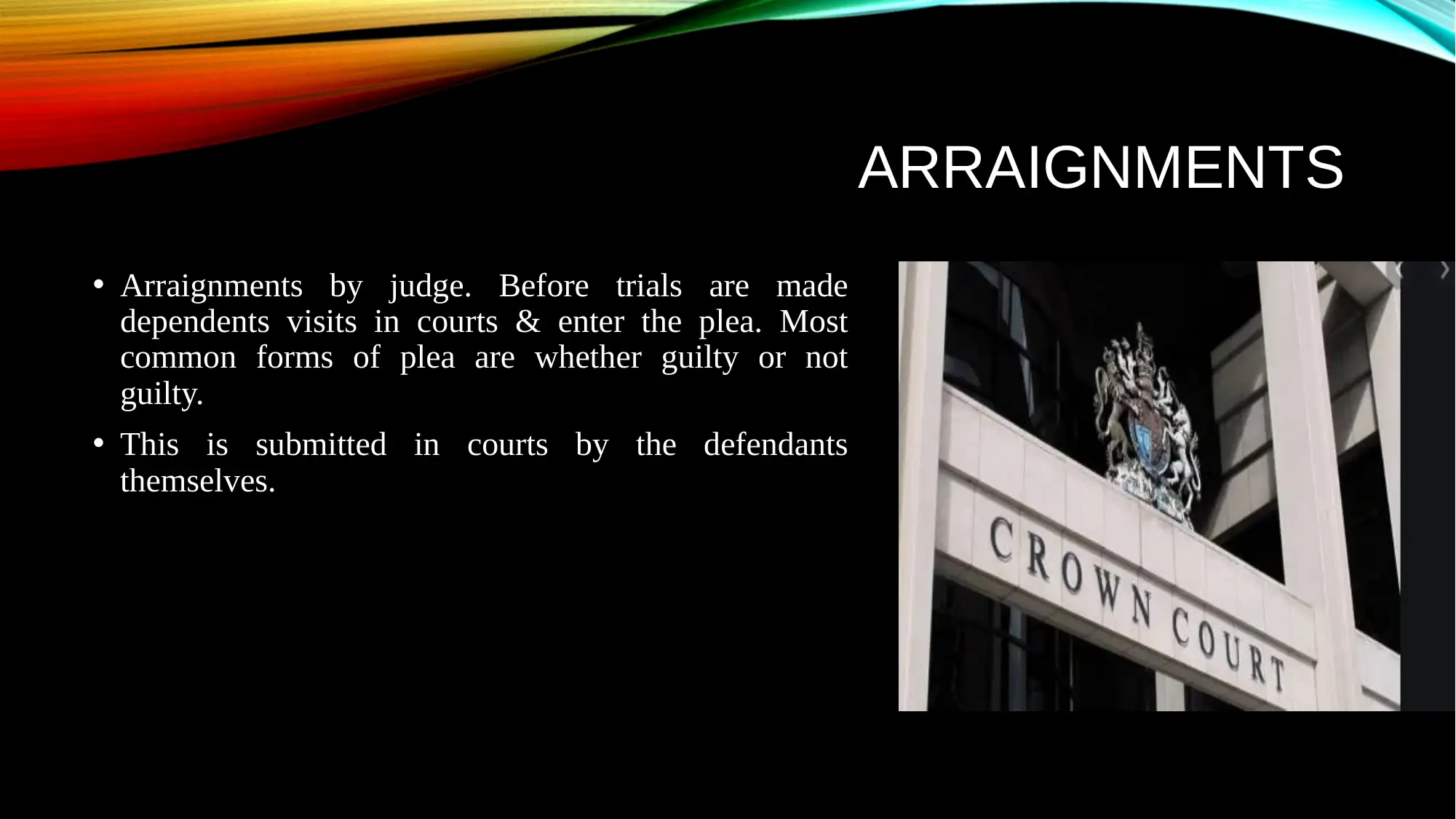
ARRAIGNMENTS
• Arraignments by judge. Before trials are made
dependents visits in courts & enter the plea. Most
common forms of plea are whether guilty or not
guilty.
• This is submitted in courts by the defendants
themselves.
• Arraignments by judge. Before trials are made
dependents visits in courts & enter the plea. Most
common forms of plea are whether guilty or not
guilty.
• This is submitted in courts by the defendants
themselves.
⊘ This is a preview!⊘
Do you want full access?
Subscribe today to unlock all pages.

Trusted by 1+ million students worldwide
1 out of 19
Related Documents
Your All-in-One AI-Powered Toolkit for Academic Success.
+13062052269
info@desklib.com
Available 24*7 on WhatsApp / Email
![[object Object]](/_next/static/media/star-bottom.7253800d.svg)
Unlock your academic potential
Copyright © 2020–2025 A2Z Services. All Rights Reserved. Developed and managed by ZUCOL.





